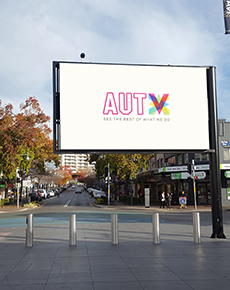AUT students’ visual work goes international

A number of students’ visual content has been selected to play on screens across AUT’s campuses, around Auckland and internationally, thanks to a collaboration between AUTV and Australian-based company, Urban Screen Productions.
Established in 2013, AUTV is a content-driven media channel, which aims to highlight the excellent work produced by AUT students and staff. By showcasing the best of what AUT students and staff do, AUTV provides a channel for students, staff, industry and the public to engage with.
The work, which was initially featured over the summer at both the Silo Park film screenings and the ASB Waterfront Theatre, is part of a collection of work curated and promoted by AUTV Creative Director, David Yetton. After meeting Emma Shearman, Operations Director from Urban Screen Productions, at an industry event in Sydney, David saw an opportunity to get a collection of student work into the international public eye.
“AUTV was created with the intention of showcasing the best of our students’ visual work. I’ve always believed in the quality of the material, so meeting the Urban Screen Productions team, with their network of screens, offered a great way to reach a wider audience,” David explained.
The thirty-minute collection of work has now gone on to be screened on public video walls as part of Orientation Week at the University of New South Wales in Sydney. Following the success of these screenings, Urban Screen Productions has played the material at Macquarie Mall in Liverpool, West Sydney, and most recently on the network of video walls in Federation Square, Melbourne.
By creating a network of screens in public spaces, Urban Screen Productions hopes to build a platform for the benefit of a variety of content producers, through the convergence of arts, culture and technology. Emma explained the reasoning behind highlighting student work to Australian audiences.
“We have collaborations with artists, students and other community groups around the world. Showing the AUT student content within the screen network in Australia is a great case-study of the breadth of the platform we’re building. We’re really keen to show student work because often, they don’t have a platform for presenting the work they do – so we like to offer something back to our communities,” she says.
David is particularly pleased to see the material getting the kind of recognition he feels it deserves.
“For our students, it’s a great opportunity and it is a great indication of the quality of their work. I think the exposure has surpassed our student’s expectations,” he says.
AUT Bachelor of Design graduate, Henry Letele’s work was selected to be featured as part of the AUTV content. His work is focussed on the changing Auckland landscape and he is excited about the opportunity to be featured internationally.
“While I was a student, I used to be inspired by all the design work on the big screens around campus, because all the great work was done by students like me. I thought, if I worked hard enough, I could achieve something on that level. I never thought my work would get up there, let alone to another country – and it’s pretty surreal honestly,” he says.
Emma further emphasised why the AUTV content works on the Urban Screen network.
“The animation content works particularly well on these large format screens. The content always looks great and it is an easy win for transient audiences – they get something lovely to look at, no matter how long they look at it.”
“Overall, the footage has been received extremely well. It is really great to have well produced ‘arts’ content for us to screen on the Urban Screens network,” Emma continues.
The content is also earmarked for screening at a new Urban Screen launching in Melbourne in October and a further screen in Sydney. There is even potential to launch the material across the Pacific to new screens coming online in Vancouver later this year.
Since AUTV’s inception, the team have created approximately 500 unique pieces of content representing the work of over 1200 students, with over 500,000 estimated views. By initiating curriculum involvement with students in various areas of the university, the continued stream of content continues to display a high degree of visual engagement and technical excellence.
“As well as showcasing the work our students are currently producing, we’re working with staff to help shape the future of visual interaction and innovation in our public spaces at AUT,” says David.
“The video walls offer a really powerful public statement on our intent in regards to being a university focussed on the future – they are a means by which we prove that we ‘walk-the-talk’.”
To submit content for consideration to AUTV’s visual content collection, or find out more about the initiative, see AUTV’s website.